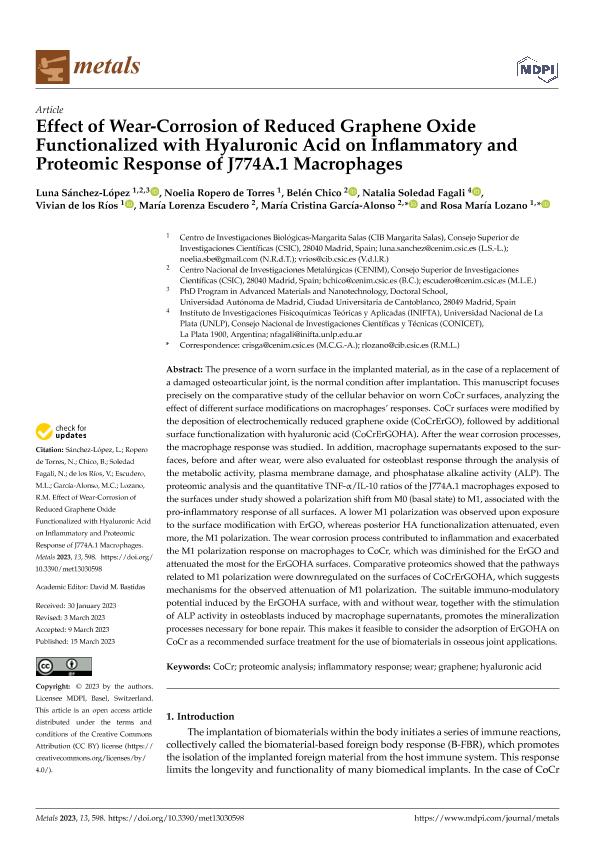Mostrar el registro sencillo del ítem
dc.contributor.author
Sánchez López, Luna
dc.contributor.author
Ropero de Torres, Noelia
dc.contributor.author
Chico, Belén
dc.contributor.author
Fagali, Natalia Soledad

dc.contributor.author
De los Ríos, Vivian
dc.contributor.author
Escudero, María Lorenza
dc.contributor.author
García-Alonso, María Cristina
dc.contributor.author
Lozano Puerto, Rosa María

dc.date.available
2024-02-15T15:10:59Z
dc.date.issued
2023-03
dc.identifier.citation
Sánchez López, Luna; Ropero de Torres, Noelia; Chico, Belén; Fagali, Natalia Soledad; De los Ríos, Vivian; et al.; Effect of Wear-Corrosion of Reduced Graphene Oxide Functionalized with Hyaluronic Acid on Inflammatory and Proteomic Response of J774A.1 Macrophages; Multidisciplinary Digital Publishing Institute; Metals; 13; 3; 3-2023; 1-28
dc.identifier.issn
2075-4701
dc.identifier.uri
http://hdl.handle.net/11336/227090
dc.description.abstract
The presence of a worn surface in the implanted material, as in the case of a replacement of a damaged osteoarticular joint, is the normal condition after implantation. This manuscript focuses precisely on the comparative study of the cellular behavior on worn CoCr surfaces, analyzing the effect of different surface modifications on macrophages’ responses. CoCr surfaces were modified by the deposition of electrochemically reduced graphene oxide (CoCrErGO), followed by additional surface functionalization with hyaluronic acid (CoCrErGOHA). After the wear corrosion processes, the macrophage response was studied. In addition, macrophage supernatants exposed to the surfaces, before and after wear, were also evaluated for osteoblast response through the analysis of the metabolic activity, plasma membrane damage, and phosphatase alkaline activity (ALP). The proteomic analysis and the quantitative TNF-α/IL-10 ratios of the J774A.1 macrophages exposed to the surfaces under study showed a polarization shift from M0 (basal state) to M1, associated with the pro-inflammatory response of all surfaces. A lower M1 polarization was observed upon exposure to the surface modification with ErGO, whereas posterior HA functionalization attenuated, even more, the M1 polarization. The wear corrosion process contributed to inflammation and exacerbated the M1 polarization response on macrophages to CoCr, which was diminished for the ErGO and attenuated the most for the ErGOHA surfaces. Comparative proteomics showed that the pathways related to M1 polarization were downregulated on the surfaces of CoCrErGOHA, which suggests mechanisms for the observed attenuation of M1 polarization. The suitable immuno-modulatory potential induced by the ErGOHA surface, with and without wear, together with the stimulation of ALP activity in osteoblasts induced by macrophage supernatants, promotes the mineralization processes necessary for bone repair. This makes it feasible to consider the adsorption of ErGOHA on CoCr as a recommended surface treatment for the use of biomaterials in osseous joint applications.
dc.format
application/pdf
dc.language.iso
eng
dc.publisher
Multidisciplinary Digital Publishing Institute
dc.rights
info:eu-repo/semantics/openAccess
dc.rights.uri
https://creativecommons.org/licenses/by/2.5/ar/
dc.subject
COCR
dc.subject
GRAPHENE
dc.subject
HYALURONIC ACID
dc.subject
INFLAMMATORY RESPONSE
dc.subject
PROTEOMIC ANALYSIS
dc.subject
WEAR
dc.subject.classification
Recubrimientos y Películas

dc.subject.classification
Ingeniería de los Materiales

dc.subject.classification
INGENIERÍAS Y TECNOLOGÍAS

dc.subject.classification
Biología Celular, Microbiología

dc.subject.classification
Ciencias Biológicas

dc.subject.classification
CIENCIAS NATURALES Y EXACTAS

dc.subject.classification
Físico-Química, Ciencia de los Polímeros, Electroquímica

dc.subject.classification
Ciencias Químicas

dc.subject.classification
CIENCIAS NATURALES Y EXACTAS

dc.title
Effect of Wear-Corrosion of Reduced Graphene Oxide Functionalized with Hyaluronic Acid on Inflammatory and Proteomic Response of J774A.1 Macrophages
dc.type
info:eu-repo/semantics/article
dc.type
info:ar-repo/semantics/artículo
dc.type
info:eu-repo/semantics/publishedVersion
dc.date.updated
2024-02-14T12:48:56Z
dc.journal.volume
13
dc.journal.number
3
dc.journal.pagination
1-28
dc.journal.pais
Suiza

dc.journal.ciudad
Basilea
dc.description.fil
Fil: Sánchez López, Luna. Consejo Superior de Investigaciones Científicas. Centro de Investigaciones Biológicas; España. Consejo Superior de Investigaciones Científicas. Centro Nacional de Investigaciones Metalúrgicas; España. Universidad Autónoma de Madrid; España
dc.description.fil
Fil: Ropero de Torres, Noelia. Consejo Superior de Investigaciones Científicas. Centro de Investigaciones Biológicas; España
dc.description.fil
Fil: Chico, Belén. Consejo Superior de Investigaciones Científicas. Centro Nacional de Investigaciones Metalúrgicas; España
dc.description.fil
Fil: Fagali, Natalia Soledad. Consejo Nacional de Investigaciones Científicas y Técnicas. Centro Científico Tecnológico Conicet - La Plata. Instituto de Investigaciones Fisicoquímicas Teóricas y Aplicadas. Universidad Nacional de La Plata. Facultad de Ciencias Exactas. Instituto de Investigaciones Fisicoquímicas Teóricas y Aplicadas; Argentina
dc.description.fil
Fil: De los Ríos, Vivian. Consejo Superior de Investigaciones Científicas. Centro de Investigaciones Biológicas; España
dc.description.fil
Fil: Escudero, María Lorenza. Consejo Superior de Investigaciones Científicas. Centro Nacional de Investigaciones Metalúrgicas; España
dc.description.fil
Fil: García-Alonso, María Cristina. Consejo Superior de Investigaciones Científicas. Centro Nacional de Investigaciones Metalúrgicas; España
dc.description.fil
Fil: Lozano Puerto, Rosa María. Consejo Superior de Investigaciones Científicas. Centro de Investigaciones Biológicas; España
dc.journal.title
Metals
dc.relation.alternativeid
info:eu-repo/semantics/altIdentifier/url/https://www.mdpi.com/2075-4701/13/3/598
dc.relation.alternativeid
info:eu-repo/semantics/altIdentifier/doi/https://doi.org/10.3390/met13030598
Archivos asociados
